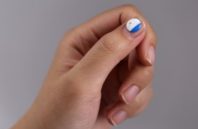Recognizing the need for a more-accurate and personalized way to measure light exposure, a team of researchers at the Northwestern University Feinberg School of Medicine and the Northwestern University McCormick School of Engineering (both in Chicago, IL) has developed a tiny wearable device that optically measures exposure to light across multiple wavelengths. What’s more, the battery-free device can record up to three separate wavelengths of light at one time.
When the solar-powered, waterproof, and virtually indestructible device was mounted on human study participants, it recorded multiple forms of light exposure during outdoor activities, even in the water. The device monitored therapeutic ultraviolet (UV) light in clinical phototherapy booths for psoriasis and atopic dermatitis, as well as blue light phototherapy for newborns with jaundice in the neonatal intensive care unit. It also demonstrated the ability to measure white light exposure for seasonal affective disorder (SAD).
As such, it enables precision phototherapy for these health conditions, and it can monitor, separately and accurately, UVB and UVA exposure for people at high risk for melanoma, a deadly form of skin cancer. For recreational users, the sensor can help warn of impending sunburn.

 (585) 768-2513
(585) 768-2513

